TSA CBT Test: X-ray Threat Categories & Free Tests
As mentioned earlier, the TSA CBT Test is divided into 5-6 image sections. These categories include different types of threats or everyday objects that can be used or modified to make them dangerous. In order to prepare for the CBT, it is important to practice detecting different objects in an X-ray image. Objects may appear in different shapes, colors, viewpoints, be in pieces, hidden under other objects, etc. TSA Career will help you discover these different categories.
This page is a part of a serie about the TSA CBT and TAB Tests.
There are a few different and important elements to consider when analyzing X-ray images:
- Angles: Each object can appear from different angles or viewpoints. Some views, for example from the front, are easy to recognize, while others make the task much more complex.
- Materials: In order to make forbidden objects indetectable when passing through X-ray machines, terrorists can use weapons made of different materials than the original ones, which makes them much more difficult to detect by screening.
- Shape: Some objects may appear in different shapes that are difficult to detect, especially if they are objects that you do not come across often in your daily life.
- Mental rotation: Objects in X-ray images may be presented upside down or sideways, making them more difficult to detect at first glance. It is important to know how to mentally rotate objects in order to discern them in the X-ray images.
- Overcrowding: In half-empty luggage, prohibited items are easily detected. However, the more a suitcase or bag is filled with various objects, the harder it becomes to distinguish potentially dangerous items.
- Overlapping: As with clutter, illegal objects underneath other objects become much more difficult to discern, both in shape and color.
These different elements make it very difficult to distinguish weapons and other dangerous objects in X-ray images, especially if you have never tried to do so before. It is therefore important to train yourself to recognize these items in all their forms, and under all conditions, in order to maximize your chance at succeeding and passing the TSA X-ray Test.
Firearms
Firearms are one of the most important categories of objects to detect in X-ray images. According to the TSA, dozens of firearms (mostly handguns) are requisitioned every week at hundreds of airports in the United States. Firearms are an overly broad category to detect in X-ray images, not only because of the wide variety of different weapons (pistols, revolvers, etc.), but also because of the materials used and the possibility of transporting them in parts or whilst containing ammunition.
Under the laws of many countries, the term "firearm" also includes any item that looks like a firearm, whether or not it is actually capable of firing. Thus, any item that may appear capable of firing a projectile or injuring someone is prohibited by most airports in carry-on luggage. This includes, but is not limited to:
- All types of firearms (pistols, revolvers, rifles, shotguns, etc.)
- Ammunition
- Parts of guns and firearms
- Realistic replicas of firearms
- Gun Powder
- Compressed air guns
- Rocket launcher
- Pellet guns
- Flare guns
- Flares
- Starter pistols
- Toy guns of all types
- BB guns
- Cap guns
- Industrial bolt and nail guns
- Crossbows
- Bolts
- Arrows
- Gun lighters
- Catapults
- Harpoon and spear guns
- Captive bolt pistol (also known as cattle gun, stun bolt gun, bolt gun and stunner)
Additionally, terrorists may use either manufactured weapons, i.e., those that were produced by professional weapons factories, or improvised weapons, i.e., those that were produced by non-professional weapons manufacturers or by the terrorists themselves. The improvised firearms can be much more difficult to detect on X-ray images due to their different sizes, shapes, and materials used. Some weapons may even be sold in disguised forms, such as a cane, a pen, or other everyday objects. Criminals may also choose to saw off the barrel of the weapon in order to change its shape, and/or disassemble and place it in strategic locations in carry-on luggage, such as hidden behind electrical components, in the lining of suitcases near metal support bars, behind dense items, or simply positions that make detection difficult.
All these elements complicate the TSO's task and they may appear in the X-ray images presented in the CBT X-ray Test. It is therefore important to familiarize yourself with the different parts of a firearm, the different possible viewpoints, and any representations of weapons or replicas that may be concealed in them.
Each firearm is generally composed of more or less identical parts, sharing the same characteristics that can be distinguished on an X-ray scanner:
Pistol
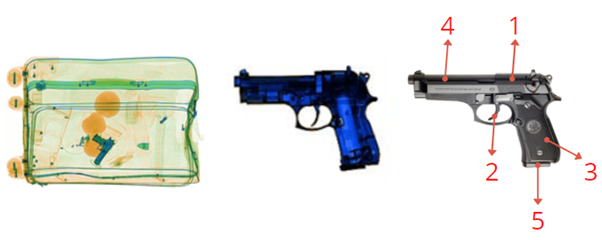
Revolver

- Slide: The slide of a gun is the upper part that covers the chamber, the mechanical parts that trigger the shot and those that manage the movement of the ammunition in the weapon. It can cover all or part of the barrel, depending on the weapon model. This part is the densest part of the weapon and consequently its color is generally the darkest (blue because it is made of steel or heavy metal).
- Trigger: The trigger is the mechanical element of a firearm that allows firing shots. It can be made of different metals or materials and thus may appear in different colors. Moreover, it can be hidden from different angles or points of view, complicating detection of the firearm.
- Grip: The grip is the handle of the weapon. It is also the part in which the magazine is inserted in a pistol. It can be made of different materials and thus appear in different colors on X-ray image.
- Barrel: The barrel is the straight shooting tube, usually made of high-strength metal. It can be entirely/partially covered by the slide, as in the case of a pistol. In conventional firearms it will always appear in blue in the X-ray images.
- Magazine: The magazine is a part found only in pistols. It will always include a spring; this is necessary in order to create enough pressure to shoot the bullets. This spring appears in X-ray images and can be used to detect the presence of a gun in an image.
- Cylinder : The cylinder is a part found only in revolvers. It is the rotating part containing multiple chambers into which ammunition is inserted.
- Cartridge: A cartridge is a type of pre-assembled ammunition for firearms. It consists of a propellant charge (usually black powder or smokeless powder) and a projectile (bullet).
Different Angles and Points of View: Pistols
In order to best prepare you, here are several examples of possible views and states of a gun, as seen under X-ray:
Slide forward without magazine and without bullets:

Top/bottom view:

Slide back without magazine and without bullets:

Slide forward with magazine and bullets:

Slide forward with magazine but without bullets:

Gun disassembled:

Magazine or cartridge only with bullets:

Real, Non-Conventional, and Toy Weapons

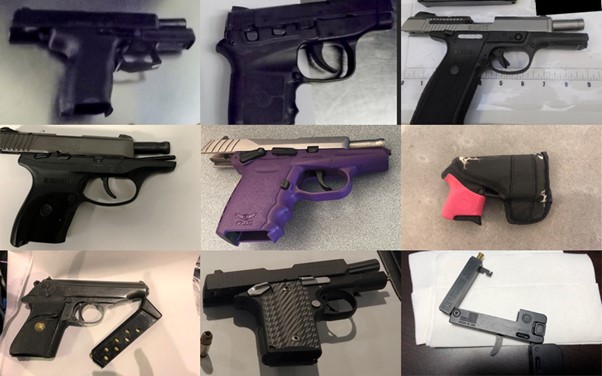
In 2019, 4,432 firearms were found during screenings at U.S. airport security checkpoints. This equates to an average of 85.2 guns per week or 12.1 guns found per day. 3,863 of the weapons were loaded.
This huge number demonstrates just how important the TSO's work in an airport is.
Free Sample Questions
Here are several examples of questions that may or may not appear with firearms. Choose answer one if you recognize a gun in the luggage. Choose answer two if you think there is no gun in the image.
Question 1
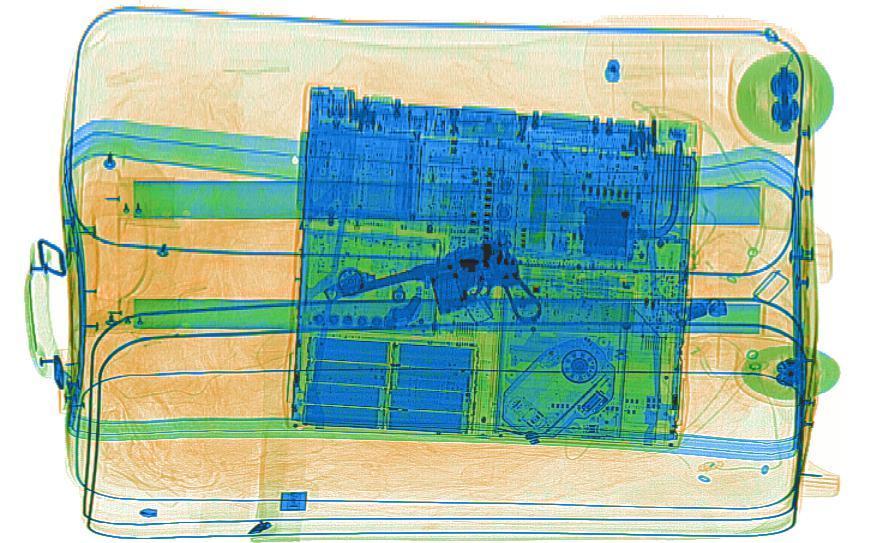
- 1
- 2
Click here to see the answer
You should have selected 1.
Explanation: You can see a weapon hidden behind the computer, appearing visibly from the front.
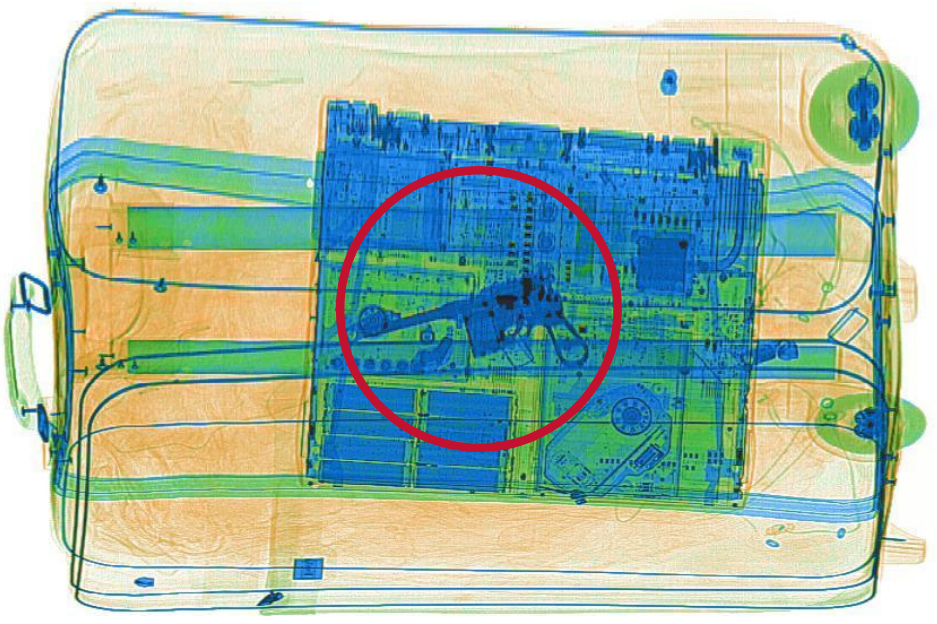
Question 2
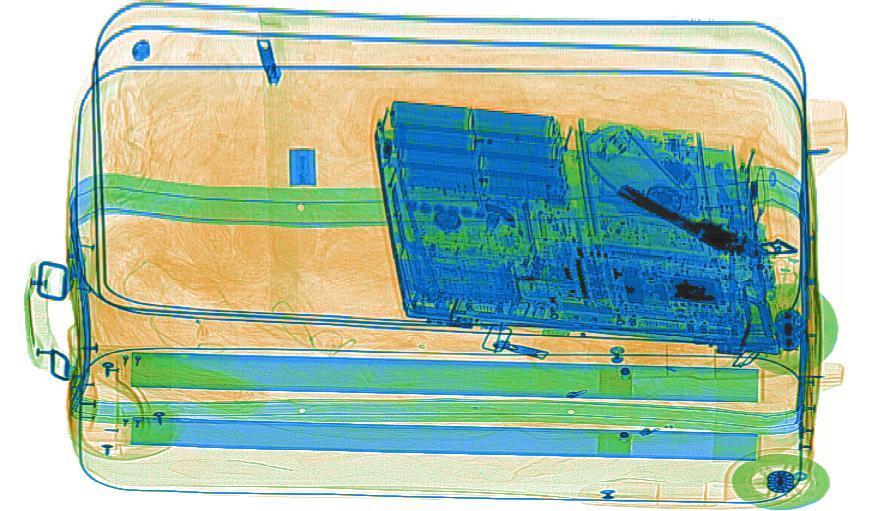
- 1
- 2
Click here to see the answer
You should have selected 1.
Explanation: Here we can also see a weapon hidden behind the computer, this time upside down.
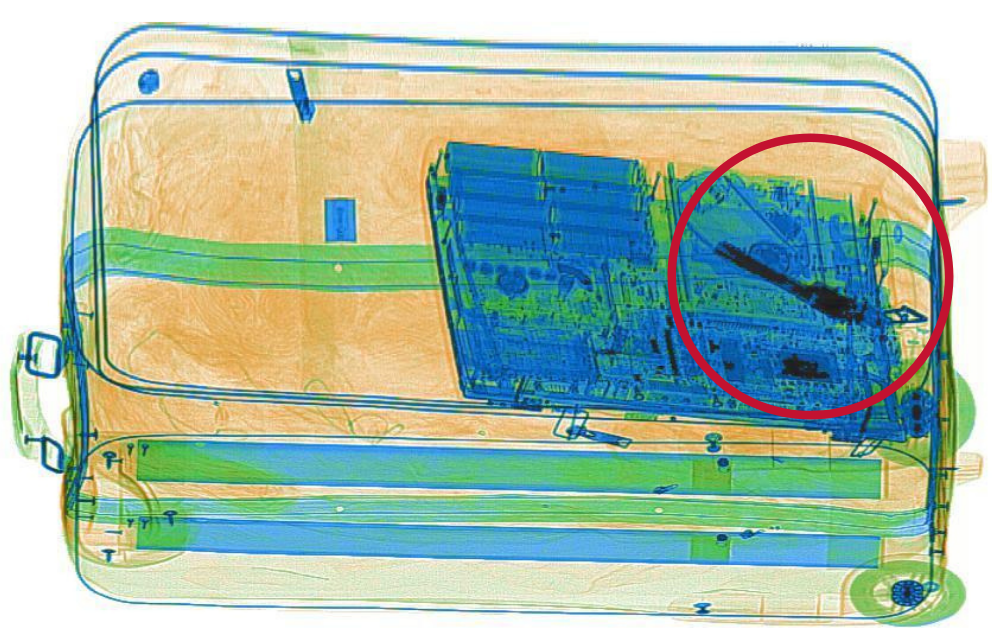
Question 3

- 1
- 2
Click here to see the answer
You should have selected 2.
Explanation: no weapon appears in this picture.
Question 4
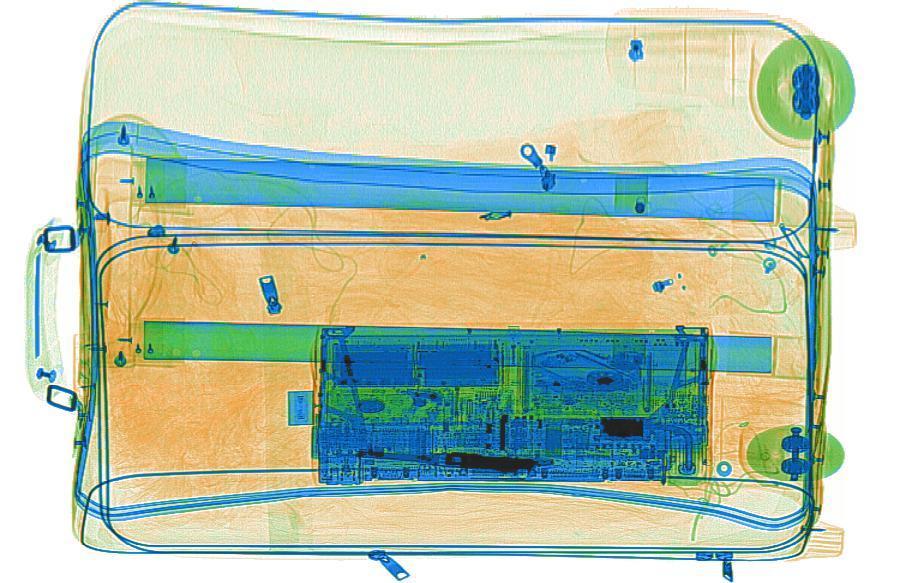
- 1
- 2
Click here to see the answer
You should have selected 1.
Explanation: In this question we can see a gun seen from above, hidden behind the computer. Only the barrel and the slide appear in this image; their higher density causes these areas in the image to appear black behind the already dense blue of the computer.
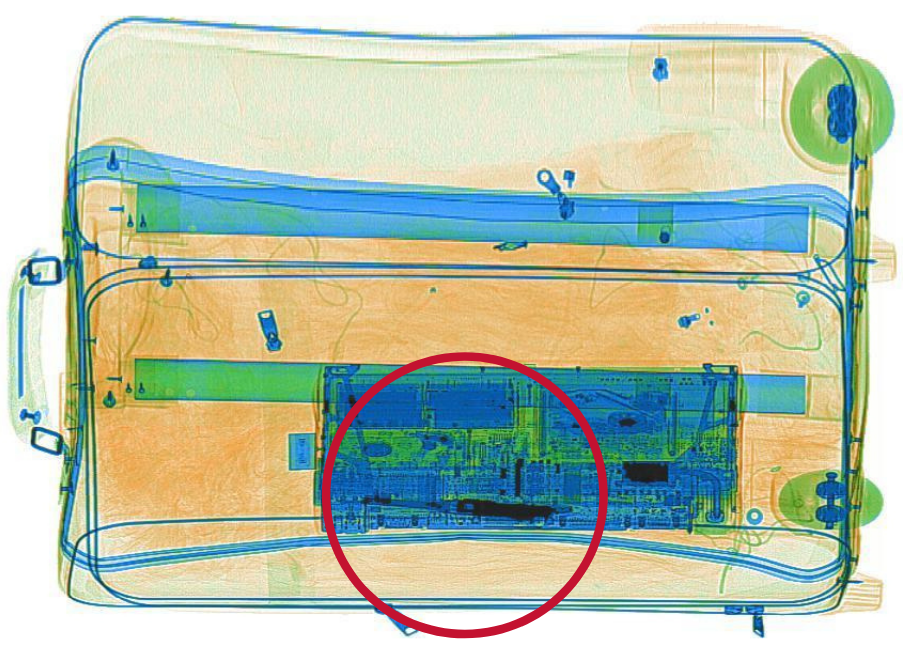
Question 5

- 1
- 2
Click here to see the answer
You should have selected 2.
Explanation: no weapon appears in this picture.
For more sample X-ray questions from the guns category, check our complete preparation pack.
Explosives
Explosives are, along with firearms, one of the greatest threats used by terrorists to achieve mass casualties. Explosives can appear in many forms, including grenades, military explosives, improvised explosive devices (IEDs), pipe bombs, and liquids.
Terrorists have used various methods to infiltrate explosives onto an aircraft. Since explosives can be of different sizes, shapes, materials, components, and colors, they are extremely difficult to detect during screening by TSOs, and constant vigilance is required when checking carry-on luggage and passengers. Indeed, explosives can be inserted inside checked luggage and hand luggage but can also be carried on the passengers themselves (for example in the heels of shoes). In addition, explosives can be concealed on or in the hand luggage of other passengers, after having been either given as a gift or under threat, or even without their awareness.
It is very likely that the TSA CBT test you take will include X-ray images with explosives. Below you will find all the necessary information about the different types of explosives, colors, densities, shapes, and sizes, as well as examples of X-ray images with explosives.
Grenades
A hand grenade is a small explosive device designed to be thrown by hand and then explode after a brief time. They come in different forms and contents: some are explosive, some are incendiary (produce intense heat due to a chemical reaction with the white phosphorus inside), and some emit smoke or gas. However, the grenade most commonly used by terrorists is the fragmentation grenade, an anti-personnel weapon designed to explode after a certain time limit (usually a few seconds).
Different Parts of a Hand Grenade

The main elements of a grenade are:
- Body: contains filler and, in certain grenades, also provides fragmentation.
- Filler: the chemical or explosive in the grenade that determines the type of grenade and its characteristics. For example, a Comp-B grenade contains a mixture of RDX and TNT, both organic materials.
- Fuse assembly: makes the grenade work by igniting or detonating the charge. It also includes a timer that allows the grenade to explode after several seconds.
- Safety pin and clip: the safety clip prevents the pin from being pulled out by accident, while the clip prevents the safety lever from moving and engaging the detonator.
Colors

The outer part of a hand grenade is usually made entirely of metal or iron. Because of this, they appear blue in the X-ray images, as in the image above.
Historical facts: In December 1985, several groups of terrorists simultaneously attacked Israeli airline El Al counters at airports in Rome, Italy and Vienna, Austria, using hand grenades and machine guns. Nineteen civilians were killed, and many were injured. To date, this attack was the last in which grenades were used.
IED – Improvised Explosive Device
IEDs – Improvised Explosive Devices, are explosives improvised by terrorists for the purpose of committing attacks. Unlike the stereotypical stick of dynamite attached to an alarm clock used as a counter, IEDs can appear in many different shapes, making them extremely difficult to detect. The materials used can often be molded into any number of different shapes and objects and even be prepared into thin sheets that can be slipped into the linings of suitcases. In addition, the densities, and other characteristics of IEDs can make them appear similar to other harmless organic materials such as leather, plastic, textiles, or food. As technology advances, IEDs are becoming more complex and difficult to detect, constantly changing and evolving. Even the smallest IEDs can have enormous destructive power, especially when detonated in the pressurized cabin of a high-flying aircraft.

Although each IED is different, the main elements remain the same.
The Explosive
Explosive materials are chemical compounds or mixtures that react to a stimulus (heat, friction, ignition, etc.) by undergoing dramatic chemical decomposition. This reaction may be an explosion, a fire, or may produce a lot of heat and gas in a very short time, thus releasing large amounts of energy. The pressure and energy released can be used to spread shrapnel, pieces of metal, or other objects being pushed out of the explosive, with the intention of injuring or killing nearby people and causing considerable damage. Explosive charges can be military, commercial, homemade, or combinations.
One of the most common types of materials used by terrorists is plastic (plastic explosives), also used by the military. Its main quality is its malleability, which allows it to adapt to all kinds of materials or to take different shapes. Moreover, it forms a binding base that surrounds the explosive material, which makes it less sensitive to heat and shock and allows it to be handled and transported with limited risk. An example of a plastic explosive is C4, which is made of a clay-like material that is ideal for camouflaging an IED. Another example is Semtex, used in the 1988 Lockerbie bombing of Pan Am Flight 103. Plastic explosives appear orange in X-ray images.
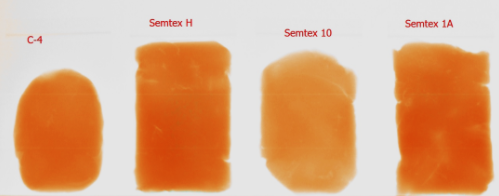
Energy Supplier
All IEDs require power, most often from regular or electronic device batteries, and usually require several batteries connected together, as with most electronic devices today. Batteries or cells are usually filled with carbon, with a metallic shell, and therefore appear blue or green (although carbon is an organic material). The presence of batteries in different objects that are not supposed to contain them should arouse your suspicion when inspecting X-ray images, as well as the presence of too many batteries, or a battery of a non-typical shape or size (e.g., round batteries in a computer). In addition, you must pay attention to batteries with pieces of solder attaching, messy wiring, and other such items, when observing X-ray images.
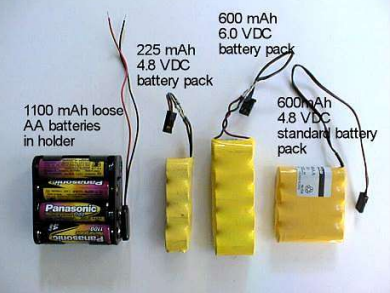

Detonator (Initiator)
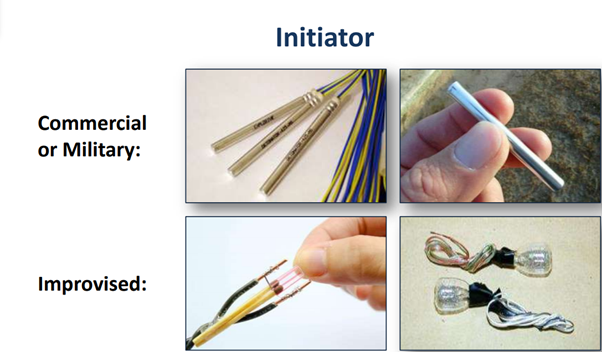
The detonator initiates the explosion process, creating a tiny explosion in its center. The detonator can be commercial, military, or improvised. It usually consists of a small pipe, made of copper, glass, or aluminum, closed on one side. Its structure is usually very delicate, containing a very small amount of explosive material in the center. Because of their small size and low density, detonators can be difficult to spot on X-ray images. They can be distinguished by detecting the presence of small parallel wires ending suddenly, or by detecting an opaque area in the center of the detonator, due to the presence of lead azide (inorganic compound), which can be thought of as a "signature", betraying the presence of a detonator.
Switch
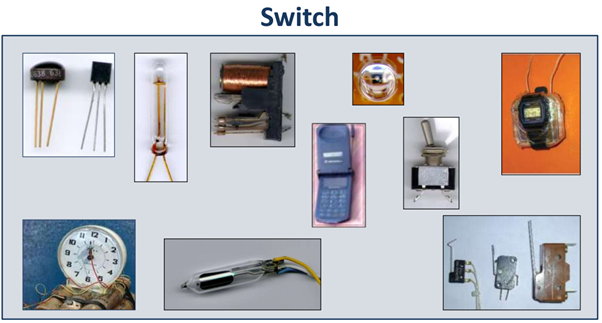
There are several kinds of switches: anti-handling switches, which are designed to be activated if the IED is handled, lifted, or opened; delay switches, which time the explosion by clockwork, digital, thermal, chemical/electrochemical mechanisms; and remote-control switches, which allow the IED to be detonated remotely. They can appear in the form of complex electronic components, telephones, watches, or even simple circular metallic cables crossing each other.
Wiring
Wiring is necessary to connect the various components of an IED. Terrorists often use cables of different lengths, without regard to the appearance of the object, and the quality of the cabling may be inconsistent with the quality of the item. In addition, there may be an excessive amount of wiring relative to the size of the object and the wires may even protrude. You should look out for all of these details when looking for IEDs in X-ray images.
Timer
A watch or alarm clock is often used as a time-delay detonation method in IEDs. The hands of the watch are used to complete an electrical circuit to detonate the explosive. However, some terrorists also use digital and electronic timers.
Colors
Depending on the nature of an IED, it may appear in different colors in the X-ray systems, usually orange or green, depending on the chemical components and their atomic number (Zeff). As a general rule, military and commercial explosives appear orange, whilst homemade IEDs tend to appear green.
Examples of Military Explosives

Plastic explosives such as C-4 or Semtex also appear orange in color:

Among the commercial explosives, most commonly used is Ammonium Nitrate (orange), often mixed with Aluminum Powder (green):

When these are mixed, the products can appear as a mixture of orange and green colors, called AN/AL. The higher the aluminum concentration in the mixture, the greener it will appear.
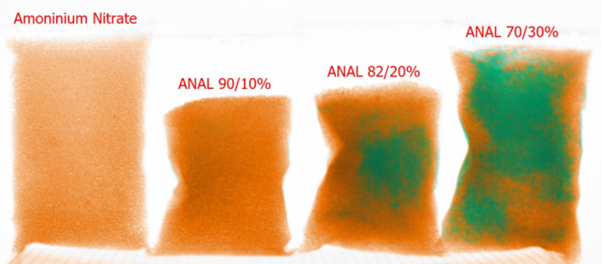
Explosives composed of inorganic materials, such as Potassium Chlorate or Potassium Nitrate, appear in green. These mixtures are used increasingly by terrorists and therefore it is important to know how to recognize them as well.

Another type of inorganic explosive that appears in green is Poor mans C-4:
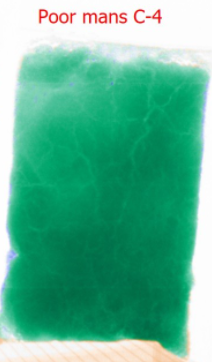
Wiring used for IED's can also appear in either orange or green. Detonator wires usually contain PETN or RDX (military explosives) and will therefore appear orange, whereas time-delayed detonator wires or amateur trigger wires usually contain black powder that appears green in the X-ray images.

Explosives can also be part of the IED's used by terrorists. Water has a higher density than explosive liquids such as diesel and therefore appears darker in X-ray images:

Another type of commonly used IEDs is called Pipe Bombs. These are built of pipes containing explosive materials, such as black powder (green under X-ray) or smokeless powder (orange under X-ray). The pipes can also be made out of various materials, for example PVC or metal (blue under X-ray). Most X-ray systems will not necessarily be able to detect the explosive in the pipe, so it is important to be able to recognize the shape of the pipe as well as the different colors in which it may appear.
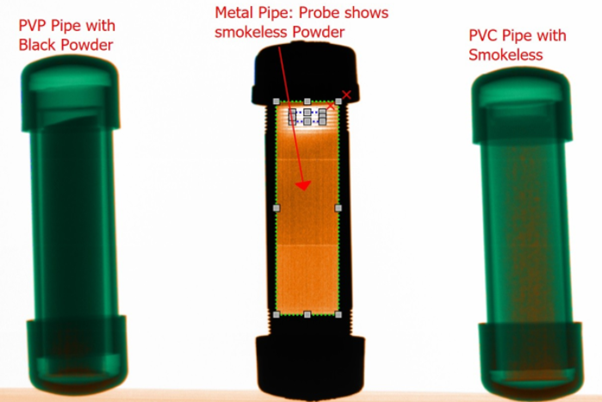
Example of a pipe bomb in a baggage:
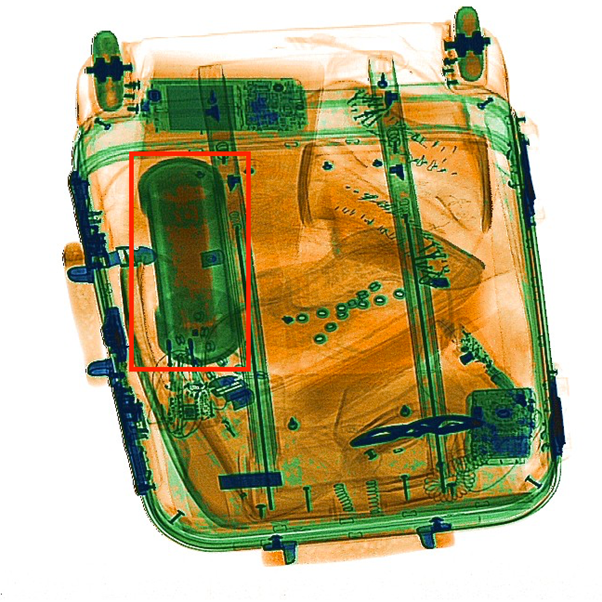
Historical facts: In 2001, an individual by the name of Richard Reid attempted to detonate an IED composed of black powder and a detonator, placed in his shoe on a flight from Paris to Miami. His attempt to ignite the explosive failed due to perspiration and he was arrested upon the plane's landing.In 2009, an individual aboard a plane from Ghana to Amsterdam attempted to detonate his underwear with a PETN detonator sewn into it. On lighting the explosive the terrorist set fire to his legs and part of the plane, but the fire was put out.
In 2011, terrorists used explosive belts consisting of 5 kg of TNT and shrapnel to detonate themselves in the arrival terminal of the Moscow airport, killing 37 people and injuring 180.
Examples of Questions
Question 1

- 1
- 2
Click here to see the answer
You should have selected 1.
Explanation: We can see an orange explosive rectangle connected to a battery and a small detonator.
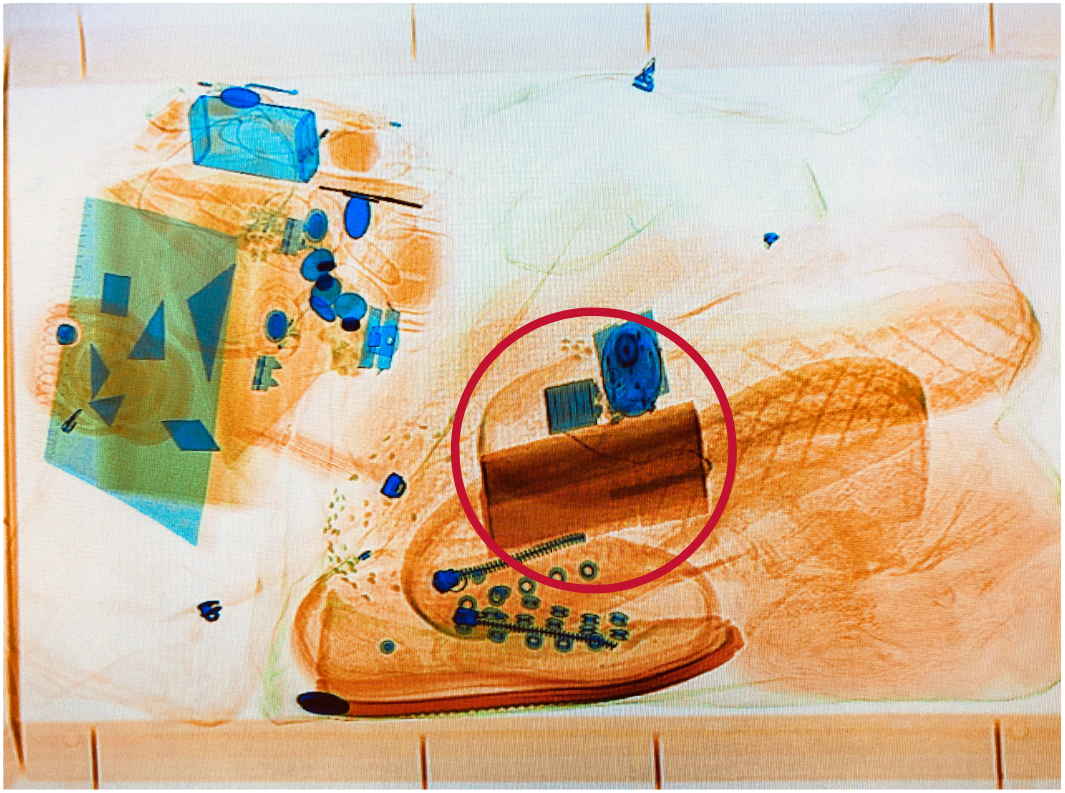
Question 2
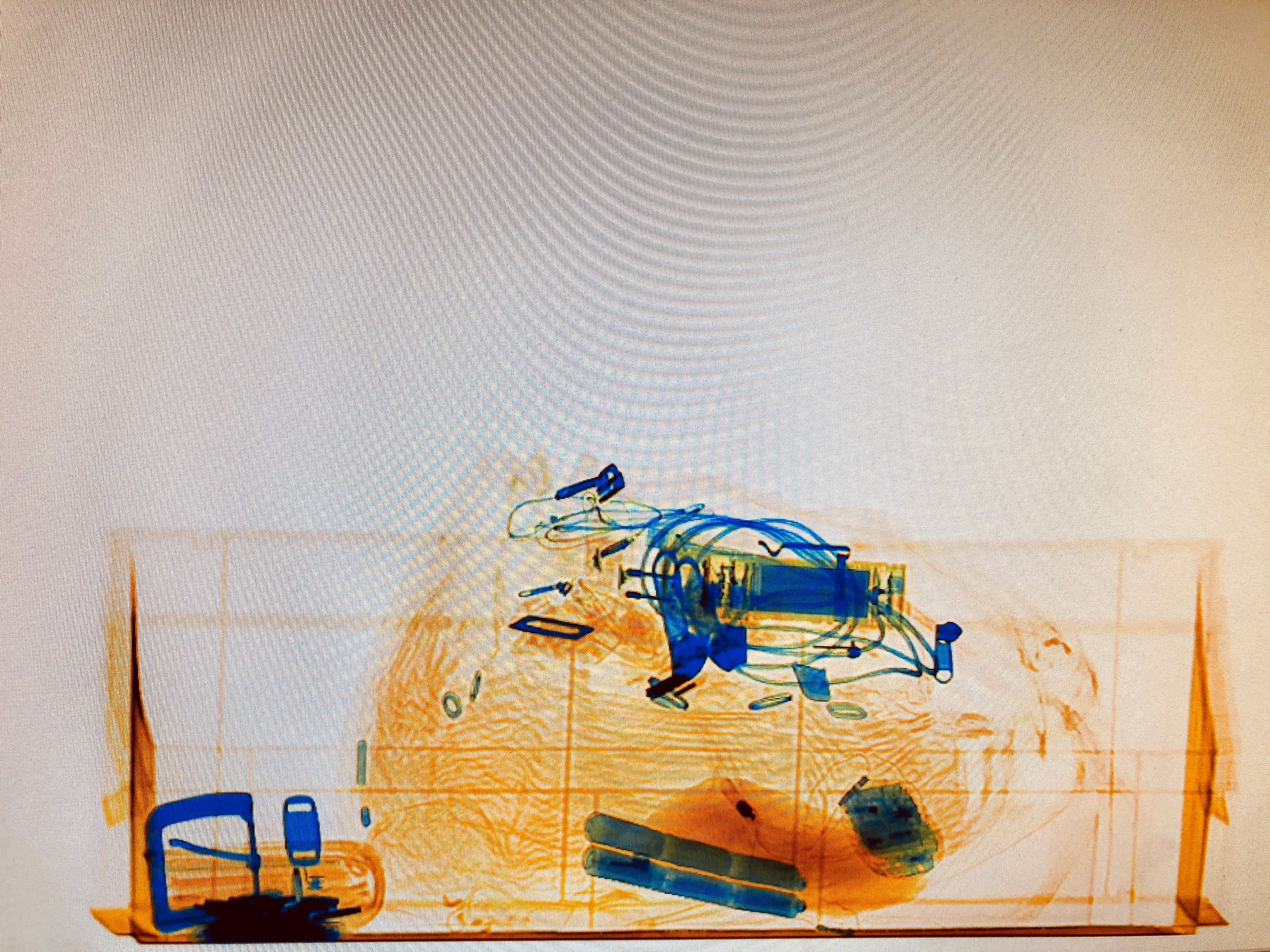
- 1
- 2
Click here to see the answer
You should have selected 1.
Explanation: In this example, we can see an organic explosive (orange) connected to batteries and a detonator.

Question 3

- 1
- 2
Click here to see the answer
You should have selected 2.
Explanation: In this example there are no explosive devices.
Question 4

- 1
- 2
Click here to see the answer
You should have selected 1.
Explanation: In this example, we can see a TNT type explosive, orange in color, with metal tips appearing blue.
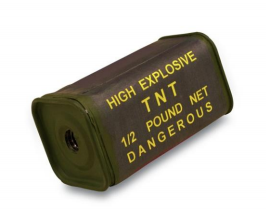

Question 5

- 1
- 2
Click here to see the answer
You should have selected 2.
Explanation: In this example, we can see that there is no explosive device, despite the presence of a knife (survival knife).
For more sample X-ray questions from the explosives category, check our complete preparation pack.
White Weapons
Bladed weapons include more than just knives and can appear in different forms. By definition, according to Wikipedia, a bladed weapon is a cutting, piercing or blunt weapon that is activated only by human force or by a mechanism to which it has been connected, excluding an explosion, and regardless of whether it is made of wood, stone, bone, edge, metal, or composite materials. This definition includes many items that are prohibited from passengers' carry-on baggage, including, but not limited to:
- Knives of all types
- Razors and razor blades
- Swords, sabers
- Scalpels
- Scissors with a blade longer than six centimeters
- Harpoons
- Arrows and darts
- Machetes and axes
- Tools that can be used as a weapon (screwdrivers, cutters, hammers, drills, bits, saws, Swiss Army knife, pliers, etc.)
- Shuriken (throwing stars)
- Ice skates
- Baseball and cricket bats
- Clubs of all types (golf clubs, clubs, sticks, pool cues, etc.)
- Field hockey or Lacrosse sticks
- Kayak or canoe paddles
- Skateboards
- Fishing rods
- Martial arts equipment (Nunchuks, brass knuckles, kubotan, etc.)
As described in the definition, knives and other edged weapons can be made of different materials, be it metal, ceramic, wood, plastic compounds, or glass. Materials other than metal, which is easily recognizable by its blue color in an X-ray image, are characterized by low density X-ray projections that can be exceedingly difficult to detect visually by the screeners. Most often, the handle and the blade of a knife will be made of different materials, e.g., wood and metal, and will therefore appear of different color and density: it is highly possible that only the handle or only the blade appear in the image. In addition, the position of the weapon or tool can strongly affect detection difficulty; a blade that is bent, turned on its side or hidden in a corner of the case will be much more difficult to identify.
Examples of Knives Made of Different Materials
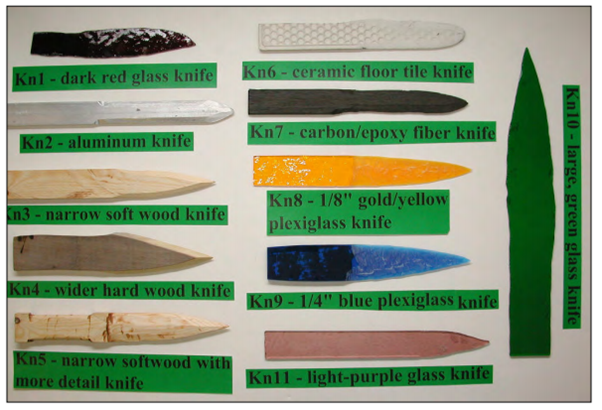
Real facts: Prior to 2001, knives with a blade less than 10 centimeters could be carried in passengers' carry-on luggage legally and were not prohibited. Following the attacks of September 11, 2001, the policy of what was allowed in carry-on luggage changed completely. In these attacks the terrorists carried knives, which they used to take control of the planes and injure several passengers and personnel, before using the planes as missiles.
Free Sample Questions
Question 1
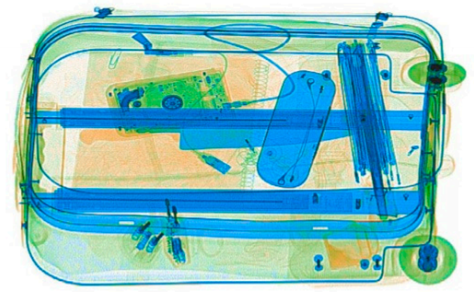
- 1
- 2
Click here to see the answer
You should have selected 1.
Explanation: In this example, you can see that there is a large knife resembling a kitchen knife in the center of the image.

Question 2
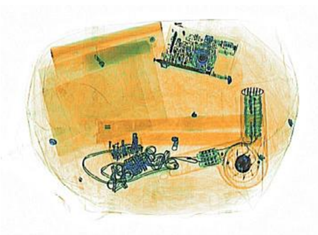
- 1
- 2
Click here to see the answer
You should have selected 1.
Explanation: In this example, we can see that there are Nunchuks in the picture. These are at the bottom and appear in orange color.


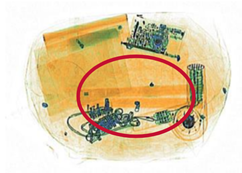
Question 3
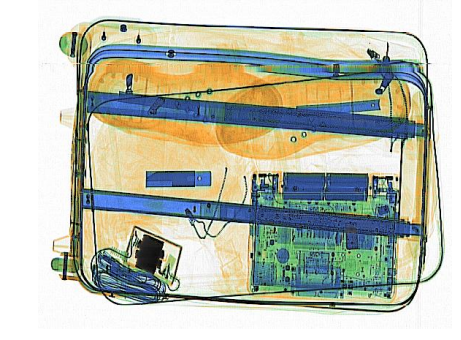
- 1
- 2
Click here to see the answer
You should have selected 1.
Explanation: In this example, we can see that there is at least one cutter in the image.


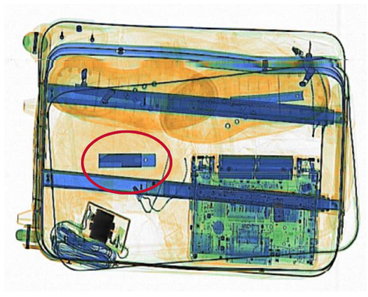
Question 4

- 1
- 2
Click here to see the answer
You should have selected 1.
Explanation: In this image you can see a knife hidden under the computer.
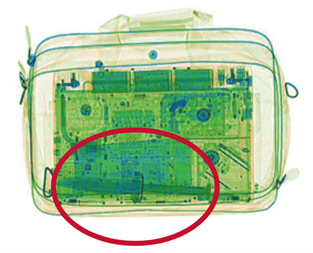
Question 5

- 1
- 2
Click here to see the answer
You should have selected 1.
Explanation: In this example, we can see a knife with a folding blade. Only the handle is visible, as the blade is folded into the handle.



For more sample X-ray questions from the knives category, check our complete preparation pack.
Drugs
Illegal substances such as drugs are obviously forbidden in airports and airplanes, and their transportation in hand luggage or checked luggage is prohibited. The transport of medication is authorized, and no special precautions are required, except for liquid medication (more than 100 ml or 3.3814 ounce). It is advisable to present liquid medications to the TSO screening your hand luggage.
Smugglers sometimes try to hide drugs such as cocaine in luggage. Cocaine is an organic product and therefore appears orange in the X-ray images. It appears as a block, usually hidden in the lining of the suitcase. Heroin also appears orange in color.
Historical facts: In July 2019, a 42-year-old woman traveling with her young son from Canada was arrested at Sydney airport with twelve kilograms of cocaine in her luggage.
Free Sample Questions
Question 1
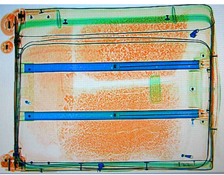
- 1
- 2
Click here to see the answer
You should have selected 1.
Explanation: In this example, there are two packages of heroin in the suitcase.
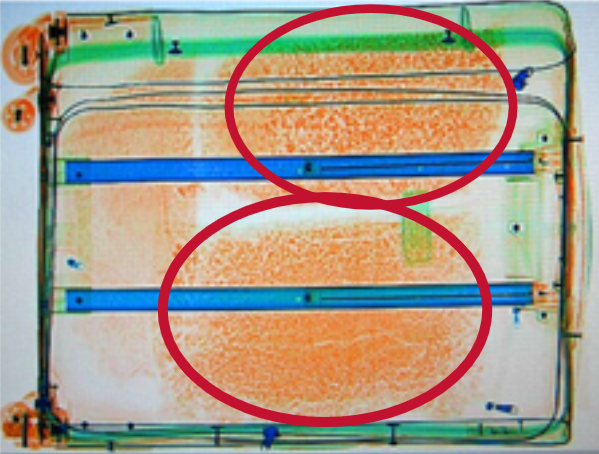
Question 2
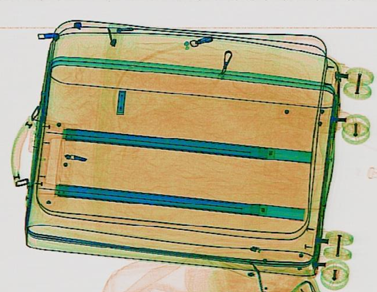
- 1
- 2
Click here to see the answer
You should have selected 2.
Explanation: In this example, no drugs can be distinguished in the suitcase. The orange background color can be attributed to many materials, including clothing. There are no distinct blocks that can be related to drugs.
Question 3

- 1
- 2
Click here to see the answer
You should have selected 1.
Explanation: In this example, there are two packages of cocaine in the suitcase.
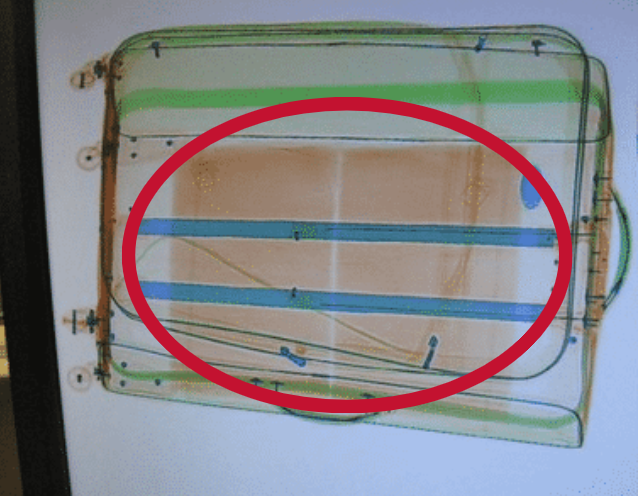
Question 4
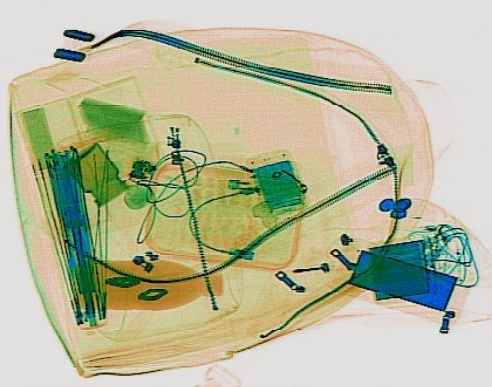
- 1
- 2
Click here to see the answer
You should have selected 2.
Explanation: In this example, the backpack does not contain drugs or illegal substances. It apparently contains a medication kit, which is not illegal to carry.
Question 5

- 1
- 2
Click here to see the answer
You should have selected 1.
Explanation: In this image you can see many packages of drugs in the suitcase, probably cocaine.
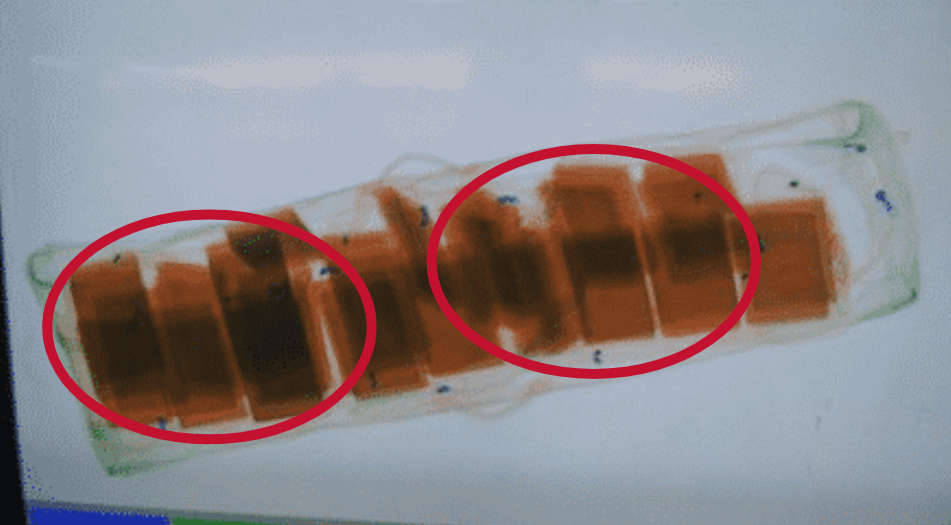
For more sample X-ray questions from the drugs category, check our complete preparation.
Tools
Tools larger than 7 inches are not allowed in carry-on luggage. However, they can be carried in checked luggage. Tools are usually made of metal and therefore appear blue on the X-ray images.
Free Sample Questions
Question 1

- 1
- 2
Click here to see the answer
You should have selected 1.
Explanation: In this example, you can see a plier on the right side of the suitcase.
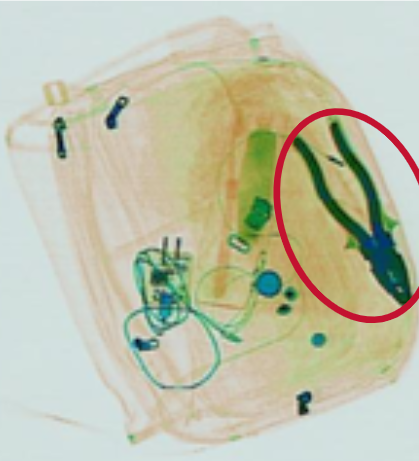
Question 2

- 1
- 2
Click here to see the answer
You should have selected 1.
Explanation: In this example, you can see three tools in the center of the case: two pliers and a wrench.

Question 3
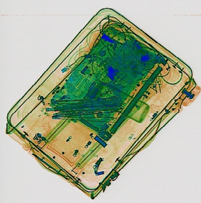
- 1
- 2
Click here to see the answer
You should have selected 2.
Explanation: There are no distinguishable tools in this image.
Question 4

- 1
- 2
Click here to see the answer
You should have selected 1.
Explanation: In this image we can identify at least one tool; a wrench in the suitcase. It is highly likely that other tools are also present.

Question 5

- 1
- 2
Click here to see the answer
You should have selected 1.
Explanation: In this image, a complete tool kit with many tools can be seen.

For more sample X-ray questions from the tools category, check our complete preparation.
Banned Items
Currently, hundreds of items are banned and cannot be carried on board an aircraft or inside an airport. To determine whether or not you can take a certain item with you we recommend visiting the TSA website, which lists all items that are allowed and prohibited. If you are studying to take the CBT test, you can also visit this page to familiarize yourself with the various restrictions.
Skills and Competencies Required
The CBT test in general, and the X-ray section in particular, require certain competencies from candidates. The exam's purpose is to ensure that they meet the requirements, skills, and values required for the TSO position:
- Visual Search: the ability to examine a visual scene (in this case an X-ray image), considering both the time limit and the entire scene.
- Figure-ground segregation: the ability to distinguish distinct objects from background clutter, using cues such as edge demarcations and different colors.
- Mental Rotation: the ability to recognize objects positioned in different orientations.
- Spatial Imagination: the ability to mentally visualize rearrangements or recombination of separate elements to form a three-dimensional object.
- Attentiveness: the ability to focus and maintain attention.
- Concentration: the ability to filter out irrelevant external stimuli such as noise or constant movement in the screening areas and to focus one's direct cognitive abilities on a primary task.
- Retention: the ability to acquire knowledge and skills at a certain level and maintain them at that level over time.
- Memory: the ability to internally reference an image or situation based on previous visual presentations or external references.
You can improve all these skills by training for the CBT X-ray test beforehand. Visit the following link to reach our preparation packs.
Did our tips help you pass the CBT test? Do you want to share your experience to encourage other candidates? We would greatly appreciate receiving any comments, testimonials, and experiences so that we can improve and help all CBT candidates succeed like you did.